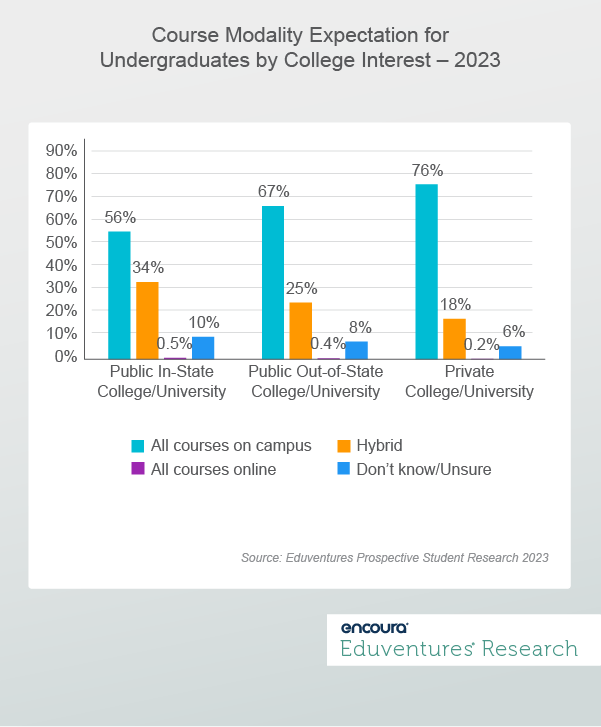New data from National Student Clearinghouse shows that while overall undergraduate enrollment grew between fall 2022 and fall 2023, freshman enrollment declined by 3.6%. Beneath these figures, certain majors are experiencing declines while others are growing. Liberal Arts and Sciences enrollment, for example, saw a 5% decline from fall 2021 to 2023, driven by an increasing focus on career-aligned majors among prospective students. This has led institutions, particularly smaller private ones, to reconsider their program offerings.
Enter course-sharing consortia: a handful of companies allowing schools to launch in-demand majors, concentrations, and embedded certificates by sharing courses—online courses—with each other. While this blurring of modality for traditional undergraduates could be a lifeline for some institutions, is it what traditional students want?
Consortia to the Rescue
Consortia are an old idea in higher education. At the end of the last century and the birth of the internet age, a new group of consortia came to be: the online learning consortia. These included Mass Colleges Online, MarylandOnline, and the Colorado Community Colleges Online, to name just a few public non-profit examples. These groups aim to provide cost efficiency for online course delivery by pooling resources across institutions within a state or local system.
Now, companies like Rize Education (Rize) and Acadeum are taking the mantle of online course-sharing consortia. They are positioning their services as a way for institutions to add new (and in-demand) majors minus the risk of additional expense or the need to wait a year or more to get a new program approved. This is allowing small (and more tuition dependent) institutions to launch new programs in fields like computer science, cybersecurity, data analytics, supply chain management, and digital marketing.
This new breed of corporate-driven platform-enabled consortia first appeared in 2015 and its growth has been spurred by the pandemic. Rize was incubated from the Lower Cost Models for Independent Colleges Consortium and launched its course-sharing platform in 2019 and reports 135 institutions as members. Acadeum is the platform for the Council of Independent Colleges Online Course Sharing Consortium, which boasts over 460 institutional members and over 12,000 online courses available for sharing. While Acadeum reports that most shared online courses are asynchronous, Rize indicates its shared online courses include both live class time and asynchronous coursework.
Another player in this field is Coursera’s Career Academy. Career Academy allows institutions to augment existing courses and programs with guided projects and professional certificates—but it is a distinctly non-credit play. It should be noted that Coursera certifications and courses are available on the Acadeum network for institutions.
Available information does not reveal any institutions offering a full 20-course major via online course-sharing. But many have added courses to supplement their own—better managing resources while bringing in more students.
Evidence of Success + Pitfalls to Avoid
The success of these course sharing arrangements cannot be ignored. One case study from Rize showed how Rochester University (MI) launched seven new programs in four months with little direct cost. To date it has had 158 applicants and 51 new deposits over two years. For some small institutions, those kinds of numbers can make an incoming class.
But these are online courses for traditional undergraduates who signed up for residential experiences. Are these students going to find it acceptable to take some portion of their courses online?
Eduventures’ Prospective Student Research™ shows that the majority of prospective undergraduates expect to have all courses on campus regardless of which type of college/university they want to attend (Figure 1).

While expectations for online courses have fluctuated in the last few years, they are roughly equal to pre-pandemic figures. Figure 1 shows that 76% of undergraduate prospects who want to attend a private school expect to take all courses on campus, compared to 67% for those wanting to attend a public out-of-state school and 56% for those interested in public in-state schools.
Adult-serving undergraduate and graduate programs have moved heavily toward fully online and hybrid modality. But among traditional undergraduate prospects who expect hybrid modality, we see a range of 18% (for private institutions) to 34% (for public in-state institutions), indicating that up to a third of students are aligned with these course-sharing strategies.
With a minority of traditional prospects expecting a hybrid experience, it begs the question about how schools are positioning these partially online programs. Do students realize they will be taking major coursework online, via another institution?
Eduventures’ initial scan of over a dozen course-sharing institutions and programs (including both Rize and Acadeum) shows that about half are explicitly promoting these courses as online or the programs as blended/hybrid. This raises a potential risk of lack of transparency about these hybrid programs and the students who may not want online courses.
The Bottom Line: The Next Phase in Course Sharing
Many small private institutions are using course sharing out of necessity. With rising enrollment pressure and mounting school closures, these consortia offer the career-focused programming that students want.
Both Rize and Acadeum highlight benefits that go beyond adding new programs. They also claim course sharing can help institutions handle prerequisites, transfer credits, dual enrollment, and student retention and engagement—especially during winter and summer terms. This sounds like a win for all sides. But given the modality expectations of traditional college students, they must ensure that students are aware of the “hybrid” nature of these programs.
Adding online courses can amplify complexity for both students and institutions as these are fundamentally tuition sharing arrangements. The question will be, with increased student enrollment revenue, will these institutions invest back into new faculty to support the programs internally, or will the new-found revenue be used elsewhere? Each institution will have to consider if online course-sharing is a temporary or long-term solution.

